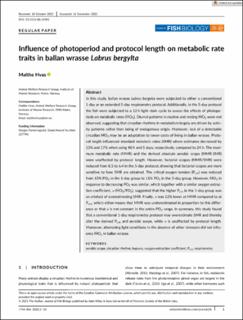| dc.description.abstract | In this study, ballan wrasse Labrus bergylta were subjected to either a conventional 1-day or an extended 5-day respirometry protocol. Additionally, in the 5-day protocol the fish were subjected to a 12 h light–dark cycle to assess the effects of photoperiods on metabolic rates (ṀO2). Diurnal patterns in routine and resting ṀO2 were not observed, suggesting that circadian rhythms in metabolism largely are driven by activity patterns rather than being of endogenous origin. Moreover, lack of a detectable circadian ṀO2 may be an adaptation to lower costs of living in ballan wrasse. Protocol length influenced standard metabolic rates (SMR) where estimates decreased by 13% and 17% when using 48 h and 5 days, respectively, compared to 24 h. The maximum metabolic rate (MMR) and the derived absolute aerobic scope (MMR-SMR) were unaffected by protocol length. However, factorial scopes (MMR/SMR) were reduced from 8.5 to 6.4 in the 5-day protocol, showing that factorial scopes are more sensitive to how SMR are obtained. The critical oxygen tension (Pcrit) was reduced from 15% PO2 in the 1-day group to 11% PO2 in the 5-day group. However, ṀO2 in response to decreasing PO2 was similar, which together with a similar oxygen extraction coefficient, α (ṀO2/PO2), suggested that the higher Pcrit in the 1-day group was an artefact of overestimating SMR. Finally, α was 12% lower at MMR compared to at Pcrit, which either means that MMR was underestimated in proportion to this difference or that α is not constant in the entire PO2 range. In summary, this study found that a conventional 1-day respirometry protocol may overestimate SMR and thereby alter the derived Pcrit and aerobic scope, while α is unaffected by protocol length. Moreover, alternating light conditions in the absence of other stressors did not influence ṀO2 in ballan wrasse. | en_US |
